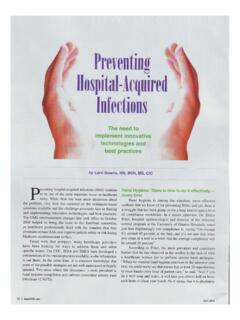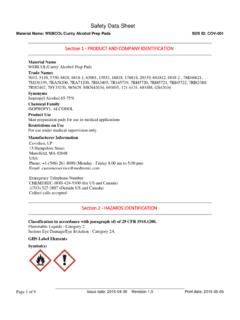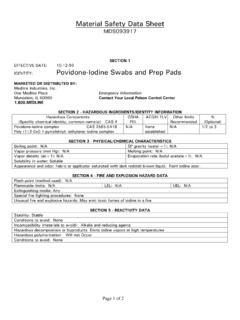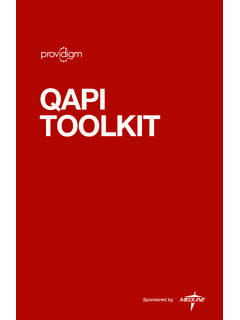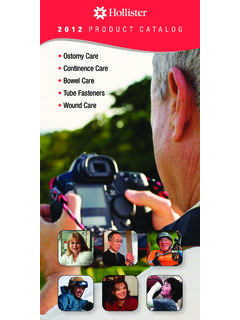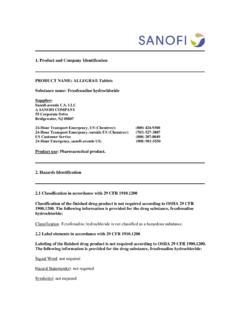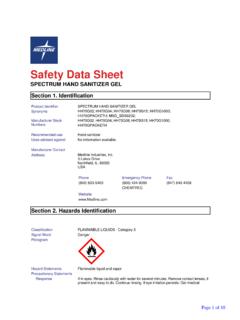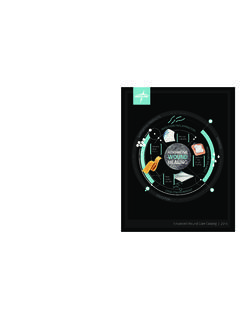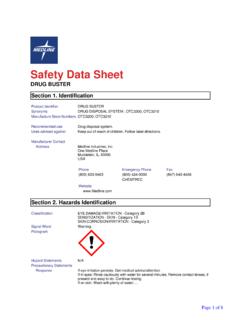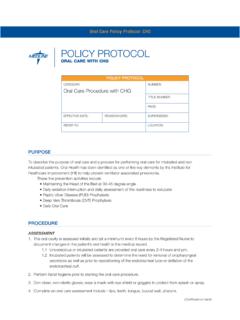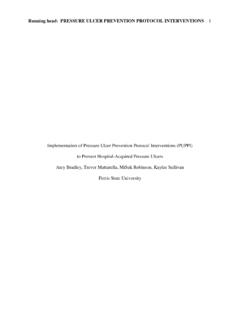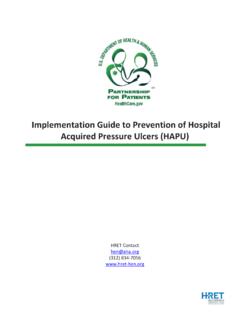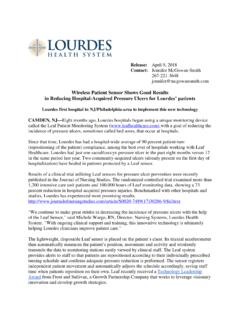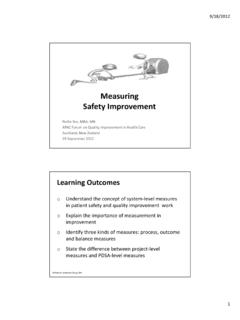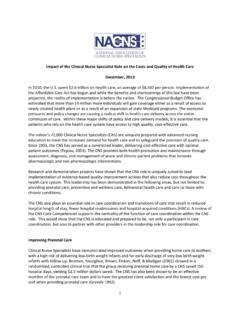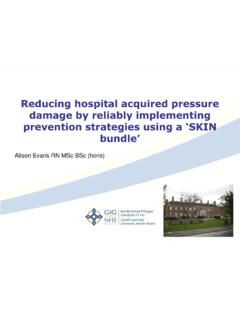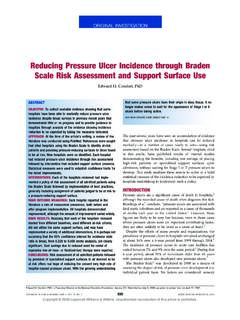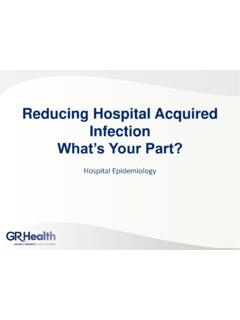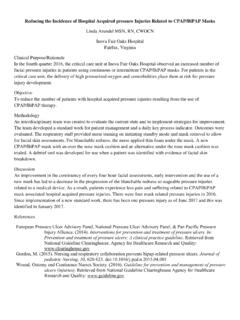Transcription of Reducing Hospital-Acquired Pressure Ulcers with a …
1 Reducing Hospital-Acquired Pressure Ulcerswith a Silicone-Based Dermal NourishingEmollient- associated skincare RegimenRonald J. Shannon, MPH; Martha Coombs, MSN, RN, CNS, CWOCN;and Debashish Chakravarthy, PhD, FAPWCAINTRODUCTIONA ccording to the Agency for Healthcare Research and Quality(AHRQ), the number of hospital patients who develop pressureulcers(PrUs) has risen by 63% over the last 10 a serious problem for patients within the acute caresetting and a significant care management challenge for clini-cians. Effective October 1, 2008, the Centers for Medicare andMedicaid Services (CMS) will no longer reimburse hospitals atthe higher diagnosis-related group rate for Stages III and IVPrUs that are not documented on AHRQ found that the average stay for patients admittedto hospitals for the treatment of PrUs was 13 days, with anaverage cost of $37,800 per hospital average acutecare hospital will spend between $400,000 and $700,000 peryear to treat also shows that the actual costs ona time line from creation of the ulcer to complete healing canreach as high as $90, 6 Nearly 9 of every 10 hospital staysinvolving PrUs were covered by government health programs 66% by Medicare and 23% by state Medicaid is another indirect cost of PrUs.
2 The average malpracticeaward in 1995 was $500, figure does not include thecosts of management time or legal fees incurred by the prac-titioners or the skin integrity is a critical factor for Reducing therisk of commercial products exist to improve skinintegrity and protect against factors that produce PrUs. In thestudy reported in this article, the authors incorporated one skincare program (Remedy; Medline Industries, Inc, Mundelein,Illinois), which is silicone based and uses dermal nourishingemollients. For the purposes of this article, this skin program isreferred to as the silicone-based dermal nourishing emollient (SBDNE) program or regimen. The SBDNE regimen contains aproprietary blend of antioxidants, amino acids, vitamins (A, B3,ADVANCES IN SKIN & WOUND CARE&OCTOBER INVESTIGATIONR onald J.)
3 Shannon, MPH, is President, Global Health Economics, LLC, Clifton Park, New York; Martha Coombs, MSN, RN, CNS, CWOCN, is Clinical Manager, Porter Adventist HospitalWound Center, Denver, Colorado; and Debashish Chakravarthy, PhD, FAPWCA, is Technical Director, Wound and Skin Care, Medline Industries, Inc, Mundelein, Illinois. Submitted April 1,2008; accepted in revised form January 26, :To determine the effect of a silicone-based dermalnourishing emollient (SBDNE) regimen on the reduction ofpressure Ulcers (PrUs) and costs in a hospital medical :PrUs represent a serious problem for patients withinthe acute care setting and are a significant care managementchallenge for clinicians. Effective October 1, 2008, the Centers forMedicare and Medicaid Services will no longer reimbursehospitals at the higher diagnosis-related group rate for Stages IIIand IV PrUs that are not documented on admission.
4 In addition,formation of PrUs in the hospital also puts the institution atfinancial risk of DESIGN AND METHODS:The wound healing centerat Porter Adventist hospital , Denver, Colorado, documentedthe Hospital-Acquired incidence rate of PrU patients in thehospital from May 2006 to December 2007. A retrospective,quasi-experimental design was used to examine the changesin PrU incidence rates and the economic effect of introducinga SBDNE regimen into an existing PrU prevention :The replacement of a mixture of ad hoc skin careproducts, none of which contained silicone-based emollients, withan SBDNE skin care regimen into an existing prevention programsignificantly reduced the proportion of Hospital-Acquired PrUs to0% after 8 months. Estimated cost savings per patient admitted tothe medical unit attributed to SBDNE averaged $ CONCLUSIONS:The use of an SBDNE skin care regimenwas important in bringing about a significant reduction in thenumber of patients with PrUs and respective treatment costs in amedical unit experiencing high incidence rates of SKIN WOUND CARE 2009;22:461 79 Copyright @ 200 Lippincott Williams & Wilkins.
5 Unauthorized reproduction of this article is , C, and D3) and methylsulfonylmethane (MSM).9 Each ofthese ingredients has been well researched for its role in basiccellular maintenance and 18 hospital CHALLENGEIn September 2006, the Porter Adventist hospital , Denver,Colorado, instituted a new management team to provide im-proved care to patients and to target the reduction of PrU ratesas an objective. Staff members completed a refresher trainingcourse to improve their focus on patient care. As a consequenceof these steps, PrU development rates began to decline to amore acceptable rate, nearer to the national average. Cliniciansconsidered the rates to be amenable to further reduction bya change in their skin care program because every other activ-ity, including education, Pressure redistribution, nutrition, andtimely removal of urine and feces, had been optimized, basedon nursing activity charts and January 2007, the wound, ostomy, and continence nursesbegan to look more specifically for causes of PrU breakdown inthe medical unit to try to further reduce PrU occurrence incidence data were collected with a focus on the recognitionof patient risk factors for skin breakdown.
6 It was discoveredduring a January 2007 evaluation that all of the patients in themedical unit with nosocomial skin breakdown were had been treated by a mixture of skin care products andbrands, with no particular thought paid to any synergy,effectiveness, or lack thereof, among these diverse making a choice in implementing a consistent skin careprogram to bring down PrU incidence rates below the nationalaverage, the SBDNE skin care product line was chosen by thewound care team because they felt it reflected the latesttechnology. Also, the range was formulated to enhance the skinimprovement effects in a synergistic fashion and includedproducts that would protect intact skin, as well as treat raw,denuded skin. A protocol for appropriate use of the products wasdrafted and in-serviced to the medical unit staff.
7 At the time ofthe skin care product change, no other additional measures weretaken to reduce PrUs beyond those already in ApproachThis study aimed to estimate the economic impact of switchingfrom ad hoc skin care products to a product regimen includingSBDNE to prevent Hospital-Acquired PrUs. Through reductionof PrUs in a medical unit, the hospital will save on treatmentcosts and the potential financial implications of 2006, Porter Adventist hospital Wound Healing Center be-gan collecting PrU incidence and prevalence data. Data collec-tion forms and instruction were provided by Kinetic Concepts,Inc (KCI), San Antonio, Texas. The forms included patient de-mographics, primary diagnosis for admittance, incontinencestatus, risk assessment scores (Braden Scale for PredictingPressure Sore Risk), prevention interventions used, and docu-mentation of PrUs (on admission and nosocomial).
8 Data werecollected on a quarterly basis, allowing for the quantification ofincidence and prevalence rates for each quarter. Additionalinformation on hospital policy and staffing changes in themedical unit was attained from the clinical manager at thewound healing hospital gave approval for the nursing staff to reviewpatient information and summarize the data for analysis. Itwas determined impractical to contact patients from the pastfor consent to use their data for analysis. The hospital is con-fident that the results are useful for the benefit of healthcaredecisions to the community and that patient information hasnot been graphical time-series analysis was used to show thechanges in incidence rates from first data collection in May2006 through December 2007.
9 The incidence rate is the numberof new cases of Pressure ulceration per unit of person-time atrisk. A chi-square analysis was used to determine statisticaldifferences in patient risk for PrUs and the proportion of PrUsacquired between the periods before implementation of theSBDNE regimen and after Braden Scale for Predicting Pressure Sore Risk scoreswere obtained from the hospital for all patients in the quarterlyreports including the pre-SBDNE and post-SBDNE Braden Scale for predicting PrU risk is validated acrossmultiple healthcare settings, including hospitalized at Porter Adventist hospital used the tool to assess 6risk areas (subscales) for developing PrUs: sensory perception,skin moisture, activity, mobility, nutrition, and subscale within the Braden Scale contains a numericalrange of scores, with 1 being the lowest score possible.
10 Thefriction/shear subscale ranges from 1 to 3; the other subscalesrange from 1 to 4. All risk areas are then added, and the totaloverall risk, ranging from 6 to 23, is determined. In the medicalunit, scores of 16 and less are used to indicate high risk, whereasscores greater than 16 indicate moderate to no risk. For pur-poses of this evaluation, the cutoff point for patients at risk ofpressure ulceration is 18 or authors also stratifiedthe risk according to a broad outline of protocols by risk leveland measured statistical differences between the 2 risk for acquiring PrUs in the hospital increases 70% of all PrUs occur in persons older than70 independentttest for equality of means comparedthe pre-SBDNE and post-SBDNE periods for differences inADVANCES IN SKIN & WOUND CARE&VOL.
